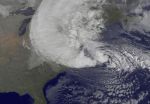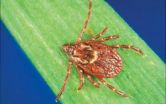(Press-News.org) Tropical storms that make their way into the North Atlantic, and possibly strike the East Coast of the United States, likely will become more intense during the rest of this century.
That's the prediction of one University of Iowa researcher and his colleague as published in an early online release in the prestigious Journal of Climate, the official publication of the American Meteorological Society.
The study is a compilation of results from some of the best available computer models of climate, according to lead author Gabriele Villarini, assistant professor of civil and environmental engineering and assistant research engineer at IIHR-Hydroscience & Engineering, and his colleague Gabriel Vecchi of the National Oceanic and Atmospheric Administration, Princeton, N.J.
"We wanted to conduct the study because intense tropical cyclones can harm people and property," Villarini says. "The adverse and long-lasting influence of such storms recently was demonstrated by the damage Hurricane Sandy created along the East Coast."
The study itself examines projected changes in the North Atlantic Power Dissipation Index (PDI) using output from 17 state-of-the-art global climate models and three different potential scenarios. The PDI is an index that integrates storm intensity, duration, and frequency.
"We found that the PDI is projected to increase in the 21st century in response to both greenhouse gas increases and reductions in particulate pollution over the Atlantic over the current century. By relating these results to other findings in a paper we published May 13, 2012 in the journal Nature Climate Change, we found that, while the number of storms is not projected to increase, their intensity is," he says.
"Moreover, our results indicate that as more carbon dioxide is emitted, the stronger the storms get, while scenarios with the most aggressive carbon dioxide mitigation show the smallest increase in intensity," he says.
INFORMATION:
The complete manuscript, "Projected Increases in North Atlantic Tropical Cyclone Intensity from CMIP5 Models," can be viewed at: journals.ametsoc.org/doi/pdf/10.1175/JCLI-D-12-00441.1.
The study was funded in part by the Iowa Flood Center.
UI researcher predicts more intense North Atlantic tropical storms
Study finds high carbon dioxide levels increase storm strength
2012-12-01
ELSE PRESS RELEASES FROM THIS DATE:
Native Americans and Northern Europeans more closely related than previously thought
2012-12-01
BETHESDA, MD – November 30, 2012 -- Using genetic analyses, scientists have discovered that Northern European populations—including British, Scandinavians, French, and some Eastern Europeans—descend from a mixture of two very different ancestral populations, and one of these populations is related to Native Americans. This discovery helps fill gaps in scientific understanding of both Native American and Northern European ancestry, while providing an explanation for some genetic similarities among what would otherwise seem to be very divergent groups. This research was published ...
Emerging vector-borne diseases create new public health challenges
2012-12-01
West Nile virus, Lyme disease, dengue fever, and plague are examples of "vector-borne zoonotic diseases," caused by pathogens that naturally infect wildlife and are transmitted to humans by vectors such as mosquitoes or ticks.
According to Marm Kilpatrick, who studies the ecology of infectious diseases at the University of California, Santa Cruz, a broad range of human activities can affect the spread of zoonotic diseases. In an article in the December 1 issue of the British medical journal Lancet, Kilpatrick and coauthor Sarah Randolph of the University of Oxford describe ...
Ancient microbes survive beneath the icy surface of Antarctic lake
2012-12-01
Researchers funded by the National Science Foundation (NSF) describe in a new publication a viable community of bacteria that ekes out a living in a dark, salty and subfreezing environment beneath nearly 20 meters of ice in one of Antarctica's most isolated lakes.
The finding could have implications for the discovery of life in other extreme environments, including elsewhere in the solar system.
If, as the researchers postulate, the bacteria survive purely from chemical reactions, as opposed to drawing energy from the sun or other sources, "this gives us an entirely ...
Vitamin D tied to women's cognitive performance
2012-12-01
Two new studies appearing in the Journals of Gerontology Series A: Biological Sciences and Medical Sciences show that vitamin D may be a vital component for the cognitive health of women as they age.
Higher vitamin D dietary intake is associated with a lower risk of developing Alzheimer's disease, according to research conducted by a team led by Cedric Annweiler, MD, PhD, at the Angers University Hospital in France.
Similarly, investigators led by Yelena Slinin, MD, MS, at the VA Medical Center in Minneapolis found that low vitamin D levels among older women are associated ...
Geoscientists cite 'critical need' for basic research to unleash promising energy resources
2012-12-01
Developers of renewable energy and shale gas must overcome fundamental geological and environmental challenges if these promising energy sources are to reach their full potential, according to a trio of leading geoscientists. Their findings will be presented on Dec. 4, at 5:15 p.m. (PT), at the fall meeting of the American Geophysical Union (AGU) in San Francisco in Room 102 of Moscone Center West .
"There is a critical need for scientists to address basic questions that have hindered the development of emerging energy resources, including geothermal, wind, solar and ...
NASA sees 'hot towers' in intensifying Typhoon Bopha
2012-12-01
Bopha intensified into a typhoon today, Nov. 30, as it continues to affect the islands in Micronesia in the western North Pacific Ocean. NASA's TRMM satellite captured rainfall data of Bopha and noticed "Hot Tower" thunderstorms as it was intensifying from a tropical storm into a typhoon.
When NASA and the Japanese Space Agency's Tropical Rainfall Measuring Mission (TRMM) satellite passed over Bopha twice on Nov. 29, and the later data showed that the area of heaviest rainfall had expanded and was still south of the center of circulation. The heaviest rainfall was occurring ...
Emerging vector-borne diseases create new public health challenge
2012-12-01
Human activities are advancing the spread of vector-borne, zoonotic diseases such as West Nile virus, Lyme disease and dengue fever, report scientists publishing a series of papers today in the journal The Lancet.
Vector-borne zoonotic diseases result from disease-causing agents or pathogens that naturally infect wildlife, and are transmitted to humans by carriers such as mosquitoes and ticks. In short, they're diseases transmitted between animals and humans.
Widespread land-use change, globalization of trade and travel, and social upheaval are driving the emergence ...
ORNL develops lignin-based thermoplastic conversion process
2012-12-01
Turning lignin, a plant's structural "glue" and a byproduct of the paper and pulp industry, into something considerably more valuable is driving a research effort headed by Amit Naskar of Oak Ridge National Laboratory.
In a cover article published in Green Chemistry, the research team describes a process that ultimately transforms the lignin byproduct into a thermoplastic – a polymer that becomes pliable above a specific temperature. Researchers accomplished this by reconstructing larger lignin molecules either through a chemical reaction with formaldehyde or by washing ...
Preventing 'Cyber Pearl Harbor'
2012-12-01
Cyber attacks that have long caused major work disruption and theft of private information are becoming more sophisticated with prolonged attacks perpetrated by organized groups. In September 2012, Bank of America, Citibank, the New York Stock Exchange, and other financial institutions were targets of attacks for more than five weeks. Defense Secretary Leon E. Panetta warned that the United States was facing the possibility of a "cyber-Pearl Harbor" and was increasingly vulnerable to foreign computer hackers who could disrupt the government, utility, transportation, and ...
NASA's TRMM satellite video reveals 2012 hurricane season rainfall
2012-12-01
The 2012 Atlantic Hurricane season was a busy one as there were 19 tropical cyclones. A new NASA animation using data from the Tropical Rainfall Measuring Mission satellite known as TRMM shows rainfall from tropical cyclones in the western Atlantic, as measured from space.
The TRMM satellite has now been making highly accurate measurements of rainfall from space for fifteen years since it launched in Nov. 1997. TRMM is a joint mission between NASA and the Japanese space agency, JAXA.
TRMM can be used to calibrate rainfall estimates from other satellites. Those rainfall ...
LAST 30 PRESS RELEASES:
University of Cincinnati experts present research at annual hematology event
ASH 2025: Antibody therapy eradicates traces of multiple myeloma in preliminary trial
ASH 2025: AI uncovers how DNA architecture failures trigger blood cancer
ASH 2025: New study shows that patients can safely receive stem cell transplants from mismatched, unrelated donors
Protective regimen allows successful stem cell transplant even without close genetic match between donor and recipient
Continuous and fixed-duration treatments result in similar outcomes for CLL
Measurable residual disease shows strong potential as an early indicator of survival in patients with acute myeloid leukemia
Chemotherapy and radiation are comparable as pre-transplant conditioning for patients with b-acute lymphoblastic leukemia who have no measurable residual disease
Roughly one-third of families with children being treated for leukemia struggle to pay living expenses
Quality improvement project results in increased screening and treatment for iron deficiency in pregnancy
IV iron improves survival, increases hemoglobin in hospitalized patients with iron-deficiency anemia and an acute infection
Black patients with acute myeloid leukemia are younger at diagnosis and experience poorer survival outcomes than White patients
Emergency departments fall short on delivering timely treatment for sickle cell pain
Study shows no clear evidence of harm from hydroxyurea use during pregnancy
Long-term outlook is positive for most after hematopoietic cell transplant for sickle cell disease
Study offers real-world data on commercial implementation of gene therapies for sickle cell disease and beta thalassemia
Early results suggest exa-cel gene therapy works well in children
NTIDE: Disability employment holds steady after data hiatus
Social lives of viruses affect antiviral resistance
Dose of psilocybin, dash of rabies point to treatment for depression
Helping health care providers navigate social, political, and legal barriers to patient care
Barrow Neurological Institute, University of Calgary study urges “major change” to migraine treatment in Emergency Departments
Using smartphones to improve disaster search and rescue
Robust new photocatalyst paves the way for cleaner hydrogen peroxide production and greener chemical manufacturing
Ultrafast material captures toxic PFAS at record speed and capacity
Plant phenolic acids supercharge old antibiotics against multidrug resistant E. coli
UNC-Chapel Hill study shows AI can dramatically speed up digitizing natural history collections
OYE Therapeutics closes $5M convertible note round, advancing toward clinical development
Membrane ‘neighborhood’ helps transporter protein regulate cell signaling
Naval aviator turned NPS doctoral student earns national recognition for applied quantum research
[Press-News.org] UI researcher predicts more intense North Atlantic tropical stormsStudy finds high carbon dioxide levels increase storm strength



